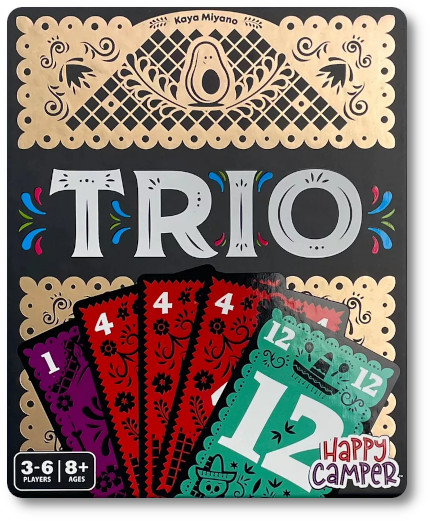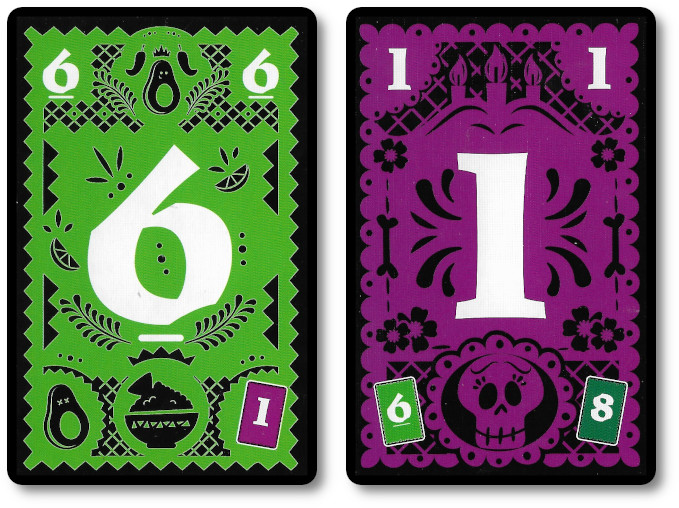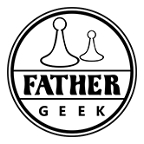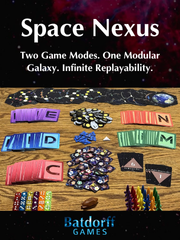 The Basics:
The Basics:
- For ages 8 and up
- For 3 to 6 players
- Approximately 15 minutes to complete
Geek Skills:
- Counting & Math
- Logical & Critical Decision Making
- Memorization
Learning Curve:
- Child – Easy
- Adult – Easy
Theme & Narrative:
- Find your matching cards as fast as you can in this creative and entertaining game of deduction and memory
Endorsements:
- Child Geek approved!
- Parent Geek approved!
- Gamer Geek approved!
Overview
William Gibson, an American-Canadian speculative fiction writer and essayist widely credited with pioneering the science fiction subgenre known as cyberpunk, said, “Time moves in one direction, memory in another.” Make no mistake, in this game, memory is essential but not the cornerstone of the gameplay nor the only element that will determine your victory. Be bold and take risks. Only those who remember and take a chance to challenge their memory will have the opportunity to be the winner in this fast-paced game that is fun for everyone.
Trio, designed by Kaya Miyano and published by Happy Camper, consists of 36 cards. The cards are as thick and durable as your standard playing card. The illustrations by Laura Michaud are bright and colorful. While the game is themeless, the artist’s illustrations are very focused on the Calavera art style (think “Day of the Dead” with candy skulls), complete with grinning skeletons, luchadores, and a royal avocado that consequently dies and gets turned into quacamole (for reasons).
Setting the Table
To set up the game, complete the following steps.
First, shuffle all the cards and deal each player a set number of cards face-down based on the number of participants in the game.
Second, deal a set number of cards face-down to the middle of the playing area in a row. This is referred to as the “middle row.”
Third, all players should pick up their cards and organize their hand to benefit them best. The suggested organization is by number value, from lowest to highest.
Fourth, as a group, determine if the game will be played in “Simple” or “Spicy” mode. If this is the player’s first time, “Simple” mode is suggested.
That’s it for game setup. Determine who will go first and begin.
Sharpen Your Mind
Trio is played in turns with no set number of turns per game. A player’s turn is summarized here.
Step One: Reveal a Card
The player can reveal one face-down card from the middle row or ask any opponent to reveal the lowest or highest value card from their hand.
Step Two: Attempt to Pair and Trio
The player now determines if they have a card of the same value or know where it resides to create a pair or a trio. For example, the player reveals a “10” value card from the middle row and has a “10” valued card in their hand to create a pair.
If the player can create a pair, they can immediately go again by asking an opponent to reveal their lowest or highest-valued card, flipping over a card from the middle row, or revealing a card from their hand. The player is good to go as long as it’s the same number value.
If the player can create a trio, they take the three cards and place them face-up in front of them. This ends the player’s turn.
If the player cannot create a pair or a trio, their turn ends, and all revealed cards are returned to their original state. Hopefully, the other players were paying attention.
Winning the Game
Victory is awarded to the first player who completes the required conditions to win the game.
If playing the “Simple” mode, the first player to collect three trios of any value or a trio of “7” valued cards wins.

If playing the “Spicy” mode, the first player to collect two connected trios or a trio of “7” valued cards wins.
“Spicy” mode, which I highly recommend, needs more explanation. On every card, except the “7”, will be one or two numbers. This number found at the bottom identifies the trio that can be connected. For example, the “1” and “6” can be connected. If you are paying attention, mathematically speaking, the connected trios are equal to “7” through addition or subtraction. Take note that the “1” card can also be connected to the “8” card for this reason (8 – 1 = 7).

Game Variant
Trio can be played with teams of two, each with two players. This allows players on the same team to swap cards. Victory is given to the first team to collect three trios, two connected trios, or the “7” valued cards trio.
To learn more about Trio, visit the game’s web page.
Final Word
 The Child Geeks quickly learned how to play and had no issues or concerns about how the game was won. They enjoyed themselves a great deal, paying very close attention to the cards and having a blast creating trios. A few Child Geeks even found the elusive and victorious trio of “7” to much fanfare and shouts of excitement. According to one Child Geek, “The game is hard and easy simultaneously. You can easily play it. Finding cards and remembering where you might have seen one gets hard.” Another Child Geek said, “This game reminds me a lot of Go Fish but is more fun. I don’t have to ask for specific cards, but I need to know where specific cards could be hiding.” When all of the games were over, the Child Geeks took a vote, and all agreed that Trio was a game they all immensely enjoyed.
The Child Geeks quickly learned how to play and had no issues or concerns about how the game was won. They enjoyed themselves a great deal, paying very close attention to the cards and having a blast creating trios. A few Child Geeks even found the elusive and victorious trio of “7” to much fanfare and shouts of excitement. According to one Child Geek, “The game is hard and easy simultaneously. You can easily play it. Finding cards and remembering where you might have seen one gets hard.” Another Child Geek said, “This game reminds me a lot of Go Fish but is more fun. I don’t have to ask for specific cards, but I need to know where specific cards could be hiding.” When all of the games were over, the Child Geeks took a vote, and all agreed that Trio was a game they all immensely enjoyed.
 The Parent Geeks were also big fans. Like the Child Geeks, they found the game to be well balanced between ease of casual play with a high difficulty level due to the need to memorize. However, as discovered by the Parent Geeks, the level of memorization was never to a point where any Parent Geek felt they were burning brain cells. As one Parent Geek put it, “A very casual and fast game I genuinely enjoyed. I’m not a fan of memory games, but this game caught my attention and made me smile. Even though it really is, I would be hard-pressed even to say that thing is a memory game. Just didn’t feel like it.” Another Parent Geek reported, “The game was fun with my family and friends, with adults, children, and the mix of both. We all had a great time and want to play the game again soon.” When the Parent Geeks took their vote, it was no surprise that they were just as enthralled with Trio as their Child Geeks.
The Parent Geeks were also big fans. Like the Child Geeks, they found the game to be well balanced between ease of casual play with a high difficulty level due to the need to memorize. However, as discovered by the Parent Geeks, the level of memorization was never to a point where any Parent Geek felt they were burning brain cells. As one Parent Geek put it, “A very casual and fast game I genuinely enjoyed. I’m not a fan of memory games, but this game caught my attention and made me smile. Even though it really is, I would be hard-pressed even to say that thing is a memory game. Just didn’t feel like it.” Another Parent Geek reported, “The game was fun with my family and friends, with adults, children, and the mix of both. We all had a great time and want to play the game again soon.” When the Parent Geeks took their vote, it was no surprise that they were just as enthralled with Trio as their Child Geeks.
 The Gamer Geeks were skeptical of this game, especially when I described it as a “light party memory game.” As it turns out, my description is precisely the kind of thing that gaming elitists do not naturally gravitate towards. In this case, however, they found that Trio was an engaging and downright entertaining game, mainly when the “Spicy” version of the rules was applied. Each game was a race, with all the players leaning forward and furiously trying to remember where the cards were while attempting to badger their opponents at the gaming table with wit and sarcasm. One Gamer Geek said, “I am shocked how much I enjoyed this game. I shouldn’t. I like games that take hours and days to complete, have multiple rule books, and give you a migraine to indicate that you are thinking at the right intensity about your next move. None of that is here, yet I still found myself engaged and laughing. I have officially grown as a person.” Another Gamer Geek stated, “Wow. Fun. Surprisingly fun. I shouldn’t have had as much fun as I did. Feel a bit bad about the fun level I experienced. I’m a gamer, for God’s sake.” When all the games were finished, the Gamer Geeks took a vote and agreed – to everyone’s surprise – that Trio was for them.
The Gamer Geeks were skeptical of this game, especially when I described it as a “light party memory game.” As it turns out, my description is precisely the kind of thing that gaming elitists do not naturally gravitate towards. In this case, however, they found that Trio was an engaging and downright entertaining game, mainly when the “Spicy” version of the rules was applied. Each game was a race, with all the players leaning forward and furiously trying to remember where the cards were while attempting to badger their opponents at the gaming table with wit and sarcasm. One Gamer Geek said, “I am shocked how much I enjoyed this game. I shouldn’t. I like games that take hours and days to complete, have multiple rule books, and give you a migraine to indicate that you are thinking at the right intensity about your next move. None of that is here, yet I still found myself engaged and laughing. I have officially grown as a person.” Another Gamer Geek stated, “Wow. Fun. Surprisingly fun. I shouldn’t have had as much fun as I did. Feel a bit bad about the fun level I experienced. I’m a gamer, for God’s sake.” When all the games were finished, the Gamer Geeks took a vote and agreed – to everyone’s surprise – that Trio was for them.
 Well, it just goes to show that there is a game for everyone and someone for every game. What I did not expect was the unanimous approval and applause this game would receive from our three groups. In truth, I thought it would be a bit of a chore, especially as the game was compared to Go Fish, a game every child has to experience and pass through on their crucible-like journey to total geekdome. Like all the other players, I was very pleasantly surprised.
Well, it just goes to show that there is a game for everyone and someone for every game. What I did not expect was the unanimous approval and applause this game would receive from our three groups. In truth, I thought it would be a bit of a chore, especially as the game was compared to Go Fish, a game every child has to experience and pass through on their crucible-like journey to total geekdome. Like all the other players, I was very pleasantly surprised.
This game is entertaining because of its speed and the ability for players to probe for cards in multiple locations. It’s a fast-paced hunt. Deducation plays just as big a part of this game as memory, adding depth and interaction that you won’t find in most memory games. It’s this interaction that also leads me to believe that referring to Trio as a “party game” is not too far from the mark. There is a very much a party-game-like atmosphere as everyone at the table plays even when it isn’t their turn. Players became increasingly interested, and the game’s speed never slowed. From the first card revealed to the last trio scored, everything happens quickly. There is an intensity here that is palatable and energizing.
Do play Trio when you have an opportunity. It’s a surprisingly entertaining small game, packing a bigger punch and challenge than expected while delivering even more smiles than it should. Give it a try for yourself to see if this little memory game is worth your time or should be forgotten as soon as possible.
This game was given to Father Geek as a review copy. Father Geek was not paid, bribed, wined, dined, or threatened in vain hopes of influencing this review. Such is the statuesque and legendary integrity of Father Geek.



